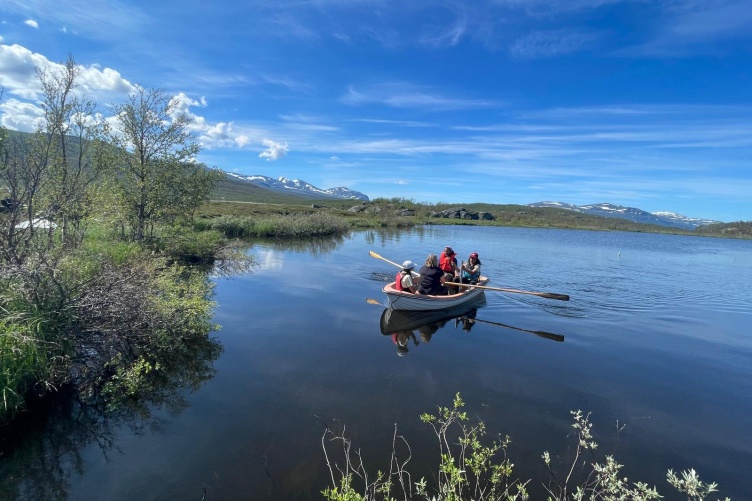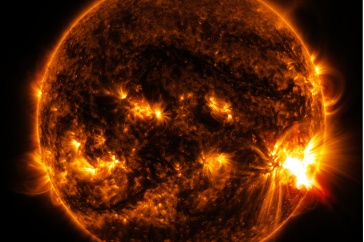
Photo by McKenzie Kuhn.
When McKenzie Kuhn traveled back to Abisko, Sweden this summer, she expected to know her walking route through the Arctic wetland — after all, she had been there just six years prior for scientific field work and knew the area intimately. But when she arrived, it looked vastly different than before: the slim wooden boardwalks used to traverse over the dense groundcover had become submerged in water, a result of rapidly thawing permafrost; many of the boards were moved to drier locations entirely where that was an option.
“Everything had shifted because the landscape had changed just in that short timeframe,” she recalls. “It’s hard to witness, but it also highlights the impacts of climate change and permafrost thaw and how quickly it can change an ecosystem.”

By some accounts, the Arctic is warming four times the rate of the rest of the world. And yet despite the grim news about climate change, Kuhn, who is a UNH postdoctoral researcher, maintains a laser focus on learning all she can about a little-known aspect of the greenhouse gas emissions coming from Arctic lakes as that region warms: the role that methanogens — methane-producing bacteria that naturally live in those water bodies — play in the methane cycle and how they contribute to climate change.
With her postdoctoral research funding provided by the National Science Foundation, Kuhn is working closely with Ruth Varner, UNH professor of Earth sciences, to learn more about these microscopic methane manufacturers. Varner’s recent $3.4 million grant from the U.S. Department of Energy will expand on these studies for an additional three years and provide a unique perspective of the same sites she’s been studying for more than a dozen years already.
“We know that lakes in that region are already large emitters of methane, but how will that change as temperatures warm? We don’t know yet,” Varner explains. “Generally speaking, there’s a positive feedback loop that happens: when more methane enters the atmosphere, then more warming occurs, which then could cause more methane to enter the atmosphere, and so on. And so, trying to understand the linkage between the microbial communities and the gas emissions is really critical.”

Graduate students and scientists in Varner’s research group, called the Trace Gas Laboratory, return to Abisko every summer to collect samples and add to their long-term dataset. This past year, Varner and UNH research scientist Florencia Fahnestock served as co-directors for a Research Experience for Undergraduate (REU) program, a summertime opportunity for students to get their feet wet — sometimes literally, if they step off those boardwalks — in the scientific research field. Kuhn helped to train the REU students in the proper field sampling techniques at a lake in Northwood, New Hampshire. Later in the summer, armed with equipment to take sediment cores from the lakes and jars to store the samples, Kuhn and the REU students trekked over the Arctic wetland toward Abisko’s warming lakes in search of methanogens. The samples will later undergo DNA and RNA sequencing to determine what specific types of bacteria are present in those lakes, and they’ll be subjected to various temperature treatments to monitor how the methanogens react — essentially, creating a warming climate scenario for them right in the lab.
Kuhn reflects on her field work experiences with her colleagues and the REU students, noting that the human relationships formed during the work keeps her coming back for more. “We’ve become a close-knit group, because it takes a team to do science,” she says. “Working with the REU students was really special, because I’ve been in their shoes before. Seeing how they view this new environment, learning about science and the ecosystem, was really refreshing.
“Arctic communities are on the forefront of climate change, and it’s important for those of us who don’t live there to be aware of what’s happening there,” she adds. “When it comes to climate change, all our actions are connected — from Durham, New Hampshire all the way to Abisko, Sweden.”
Varner holds appointments within the UNH College of Engineering and Physical Sciences and the Earth Systems Research Center.
The UNH Institute for the Study of Earth, Oceans, and Space (EOS) is UNH's largest research enterprise, comprising six centers with a focus on interdisciplinary, high-impact research on Earth and climate systems, space science, the marine environment, seafloor mapping and environmental acoustics. With approximately 100 principal investigators managing more than 400 individual grant awards, and with annual expenditures exceeding $45 million, EOS fosters an intellectual and scientific environment that advances visionary scholarship and leadership in world-class and graduate education.
-
Written By:
Rebecca Irelan | Institute for the Study of Earth, Oceans, and Space | rebecca.irelan@unh.edu | 603-862-0990



















































